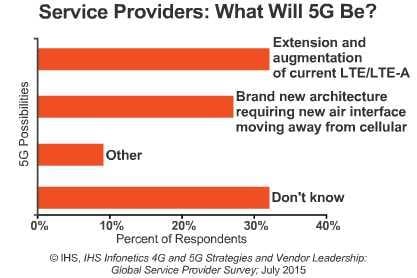IHS-Infonetics: True 4G (LTE Advanced) is Finally Happening; SPs What’s 5G?
IHS-Infonetics today released excerpts from its 2015 IHS Infonetics 4G and 5G Strategies and Vendor Leadership: Global Service Provider Survey, for which operators were interviewed about their LTE network deployment plans, challenges and service offerings. Half of respondents participating in the study say they have already deployed LTE-Advanced (LTE-A) in their LTE networks.
4G AND 5G STRATEGIES SURVEY HIGHLIGHTS:
- Inter-band carrier aggregation is the most common and very first LTE-Advanced feature deployed by respondent operators.
- Commercial voice over LTE (VoLTE) service is taking off slowly and ramping this year and next.
- 4G network functions virtualization (NFV) migration won’t happen any time soon because the bulk of LTE networks are brand new and, therefore, mobile operators are not ready to undertake migration that soon.
- Ericsson, Huawei and Nokia (in alphabetical order) are perceived by survey respondents as the top LTE equipment manufacturers.
Analyst Comments:
“We are slowly but surely moving to true 4G, and that’s good news. However, most users already believe they are on 4G, and that’s the bad news because the experience is far from consistent and is falling short of expectations. How many times does your smartphone display LTE or 4G and you still see the infamous spinning wheel?” said Stéphane Téral, research director for mobile infrastructure and carrier economics at IHS.
“The 5G debate has started with great fanfare, hype and confusion, but little substance about what it is exactly and what it is not. For now, the mindset is still locked into mobile broadband as we know it with LTE, so it’s good that the ITU has just stepped in to define 5G in its brand new IMT-2020,” Téral said.

Author’s Notes:
1. What survey respondents think 5G will be at this time is anyone’s guess. That’s because ITU-R hasn’t even finalized the 5G vision or architecture recommendations. Please refer to this post for the status of all the 5G work in progress:
2. One huge problem for “true 4G” users is there is no set of minimum service requirements a wireless carrier has to implement to claim compliance with LTE Advanced. It seems that a higher data rate than LTE along with Carrier Aggregation is what most wireless operators are implementing or planning. See Appendix for LTE Advanced Requirements.
In a July 23rd email, Stephane Teral corroborates the above problem:
Hi Alan, I agree and this is exactly what’s looming for 5G if no one, including the ITU, does not step in to call for the clear cut! At this point, everyone implementing carrier aggregation can claim true 4G (IMT-Advanced), which is much better than saying LTE is 4G when it is defined in the IMT2000 as a 3G technology!
Best wishes,
Stéphane
4G/5G SURVEY SYNOPSIS:
For the 38-page 2015 4G and 5G Strategies and Vendor Leadership: Global Service Provider Survey, IHS interviewed purchase-decision makers at 22 mobile, incumbent, competitive and cable operators from EMEA, Asia, North America and Latin America. The study covers LTE network build-out plans; challenges and drivers; migration scenarios; LTE features, services and suppliers; and operator ratings of LTE manufacturers (Alcatel-Lucent, Cisco, Ericsson, Huawei, Nokia, Samsung, ZTE) on 9 buying criteria.
The service providers participating in the study represent about one-third of the world’s telecom capex and revenue.
To purchase the report, please visit: www.infonetics.com/contact.asp
RELATED RESEARCH:
Mobile Services Market Dragged by Europe Again:
http://www.infonetics.com/pr/2015/Mobile-Services-Subscribers-Market.asp
LTE Peaking at $6 Billion a Quarter – Not Enough to Offset 2G/3G Decline:
http://www.infonetics.com/pr/2015/1Q15-Mobile-Infrastructure-Market-Highlights.asp
Operators Spent $67B Outsourcing Network Tasks to Equipment Vendors in 2014:
http://www.infonetics.com/pr/2015/Service-Provider-Outsourcing-Highlights.asp
Telecom Carrier Spending Entering New Era Marked by Diverse Regional Trends:
http://www.infonetics.com/pr/2015/2H14-SP-Capex-Rev-Capex-by-Eqpmt-Highlights.asp
Mobile Operators Using EDGE, HSPA+ to Improve User Experience on Road to LTE:
http://www.infonetics.com/pr/2015/IP-RAN-3GPP-Strategies-Survey-Highlights.asp
Appendix: LTE Advanced Requirements:
General Requirements
- LTE-Advanced is an evolution of LTE
- LTE-Advanced shall meet or exceed IMT-Advanced requirements within the ITU-R time plan
- Extended LTE-Advanced targets are adoptedSystem
System Performance Requirements
- Peak data rate
– 1 Gbpsdata rate will be achieved by 4-by-4 MIMO and transmission bandwidth wider than approximately 70 MHz
- Peak spectrum efficiency
– DL: Rel. 8 LTE satisfies IMT-Advanced requirement
– UL: Need to double from Release 8 to satisfy IMT-Advanced requirement
- Capacity and cell-edge user throughput
– Target for LTE-Advanced was set considering gain of 1.4 to 1.6 from Release 8 LTE performance
Other Important Requirements
- Spectrum flexibility
– Actual available spectra are different according to each region or country
– In 3GPP, various deployment scenarios for spectrum allocation are being taken into consideration in feasibility study
– Support for flexible deployment scenarios including downlink/uplink asymmetric bandwidth allocation for FDD and nonâ€contiguous spectrum allocationTotal
- LTE-Advanced will be deployed as an evolution of LTE Release 8 and on new bands.
- LTE-Advanced shall be backwards compatible with LTE Release 8 in the sense that
– a LTE Release 8 terminal can work in an LTE-Advanced NW,
– an LTE-Advanced terminal can work in an LTE Release 8 NW
- Increased deployment of indoor eNBand HNB in LTE-Advanced.


